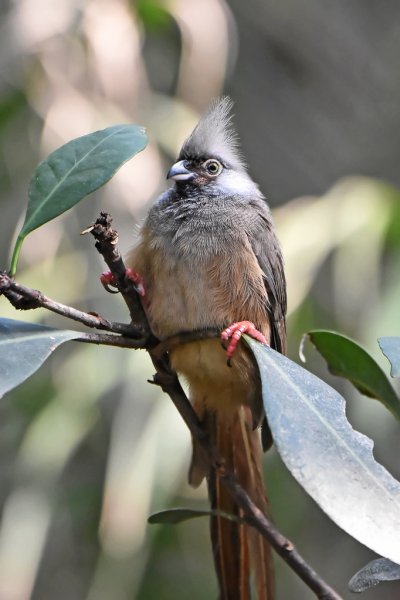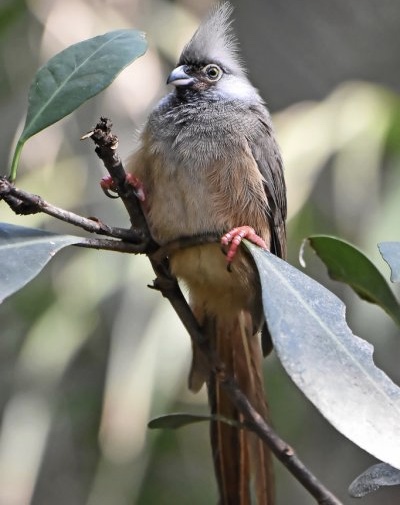ANIMAL: Speckled Mousebird Colius striatus Type of Animal: Mousebird Habitat: Savanna, scrubland, woodland, riverine woodland, open bush, bushveld, towns, gardens, parks, orchards, areas w/ tangled thickets, urban/suburban areas w/ parks/gardens/orchards/hedges, forests/forest edges/forest clearings, abandoned cultivations, found from sea level to 9,186.35 ft Location(s): Sub-Saharan Africa Appearance: Dull mousy gray-brown on back/head, prominent crest, long tail, black upper bill, pinkish lower bill, juveniles have shorter crests Food/Diet: Fruits, berries, leaves, seeds, nectar, flowers, blossoms, buds, dead bark, vegetables, eggs, crickets, worms, ants, termites, insect larvae, soil, clay-earth, pebbles Status in Wild: Stable Conservation: Breeding in zoos & wildlife parks Lifestyle: Flocks of around 15 birds. Older chicks often help in raising younger chicks. Additional Info: Called: Male: Cock Female: Hen Young: Chick Group: Flock Weight: 1.8 oz Gestation: 2.5 weeks Life Span: 8-10 years Height: 11.81-14.17 in Body Length: 11.81-14.17 in Tail Length: 6.69-9.45 in Main predators are snakes, crocodiles, monitor lizards, predatory birds, & carnivorous/omnivorous mammals. Flocks fly in single file w/ alternating humming wing-beats & glides w/ stiff long tail feathers. Roost very tightly next to each other for warmth at night. Sometimes go into torpid state on very cool nights. Females lay 1-7 eggs. Escapes predators by flying into trees/bushes/other vegetation, then freezing until danger past. Make warbling tsu-tsu call while in flight & tisk-tisk alarm call. These birds have a slow metabolism. Often sunbathe early in morning to raise body temp after lowering it at night to save energy. Birds often engage in mutual preening. Somewhat popular in bird trade. Often, many birds lay eggs in same cup-shaped nest made from grass/herb stems/twigs lined w/ softer material like plant down & spider webs. Sometimes random items like cloth, paper, & wool used. Fun Fact(s): Swallow soil & pebbles to help digest food. Very acrobatic feeders, often feeding upside down. Reversible outer toes give them ability to hang upside down & climb. Mortality rate of chicks/eggs very high-only half of eggs hatch & of those that do, only half reach 2 months. Sexually mature at 6 months old. Get name from similar appearance to mouse when moving through vegetation.

